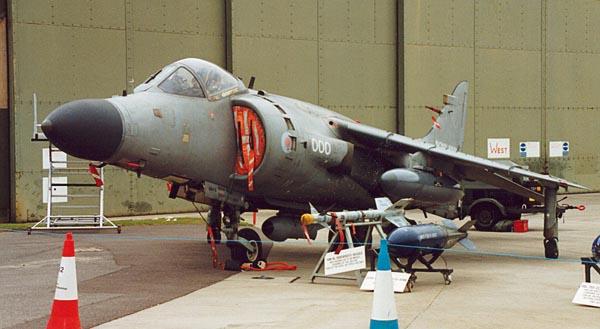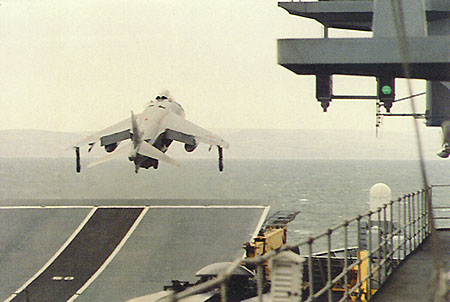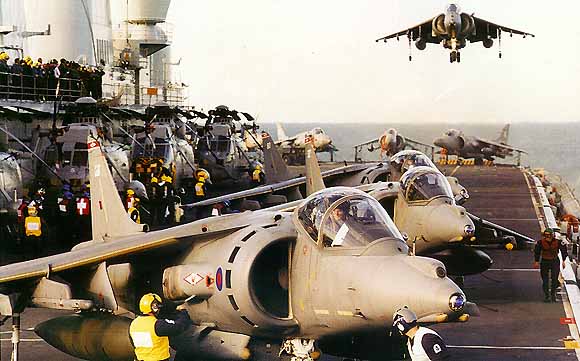Superbird"s HARRIER | home
The AV-8 Harrier | programme | design features | structure | landing gear | power plant | accommodation | avionics | armanent | specifications | Sea Harrier | feedback | superbird himself
Sea Harrier
The Sea Harrier fighter , which is in service with the British Royal Navy and the Indian Navy , provides air defence for the carrier fleet , particulary against low-flying attack aircraft armed with long-range air-to-surface missiles.
The design of the aircraft is optimised for air-to-air with secundary missions of surveillance , air-to-sea and air-to-ground attack.
The FA-2 is the latest version of the Sea Harrier in service with the Royal Navy (45 aircraft).
The aircraft is able to detect and destroy threats before the launch of an attack using long range weapon systems with look-down and shoot-down tactical capability.
COCKPIT:
The cockpit is fitted with Down Displays (HDD) and a Head Up Display (hud) from Smiths Industries.
Smiths Industries also supply the airdata computer , engine control computer , engine indicators , fuel management and gauging , airdata indicators , radar indicator , stores management system , and the weapon aiming and display computer.
The cockpit is equipped with a Vinten sisplay recording system for the HDD"s and HUD and a Martin Baker mk10h rocket -ejection seat.
WEAPONS:
A Smiths Industries weapon stores management system ensures the correct selection and release of weapons.
The aircraft has five weapon stations.
Weapons are mounted on Frazer-Nash rail launchers , Raytheon LAU-106A ejection-launchers and Varo LAU-7 rail launchers.
The FA2 is equipped with the Raytheon AIM-120A AMRAAM medium range air-to-air missile , which is an all weather , fire and forget missile, equipped with an active radar seeker and range of over 50 miles.
The AIM-9M/L Sidewinder air-to-air missile provides the Harrier with capability for firing close range at an approaching enemy aircraft in a dogfight.
The Lockheed Martin/Raytheon Sidewinder M/L has an all-aspect active optical seeker.
The Sea Harrier"s anti-ship missile is the Matra-Bae Dynamics Sea Eagle, a fire-and-forget sea-shimming missiles with active radar homing and a range of over 50 miles.
The Sea Harrier can carry the Matra Bae Dynamics ALARM anti-radiation missile, which can be deployed in direct attack mode against a radar or in loiter mode, where the missile is launched in the vicinity of the threat and waits for the hostile radar to emit.
COUNTERMEASURES:
Sea Harrier is equipped with the BAE SYSTEMS Sky Guardian 200 radar warning reciever and the AN/ALE40 chaff and flare dispenser from Tractor and Raytheon.
AN/ALE-40 is capable of launching chaff, flares and active expendable GEN-X radar decoys.
SENSORS:
The FA2 Harrier is fitted with a BAE SYSTEMS Blue Vixen pulse Doppler all-weather radar.
Blue Vixen is a multi-mode radar which performs ground mapping and surface target detection and tracking in addition to long-range look-up and look-down detection and tracking of aircraft.
The radar also interfaces to the AMRAAM missile system.
An F.95 surveillance camera is installed in the nose of the aircraft together with a cockpit voice recorder for surveillance mission evaluation.
NAVIGATION AND COMMUNICATIONS:
The Sea Harrier has an AD 2770 Tacan tactical air navigation system from BAE SYSTEMS and MADGE Microwave Airborne Digital Guidance Equipment from Thomson Thorn.
The Royal Navy Sea Harrier FA2 update programme includes the fitting of a reversionary IPG-100F global positioning system from Rockwell-Collins (UK) Ltd.
The communications suite consist of an AD120VHF radio from BAE SYSTEMS and a AN/ARC-164ARC radio from Raytheon.
The identification friend or foe system is the Allied Signal AN/APX-100MK12 or the PTR446 IFF.
ENGINE:
The single turbofan engine is teh Rolls-Royce Pegasus Mark 104 or Mark 106 which has four rotable cascade-type exhaust nozzles.
For take-off the nozzles are initially in the fully aft position and then they are rotated partially downwards for lift-off and acceleration.
Viffing(vectoring in forward flight). a form of advanced combat manoeuvre developed by V/STOL pilots, is achieved by vectoring the nozzles at high speed for sudden deceleration and very tight turns.
The Royal Navy FA2"s may be fitted with the upgraded Pegasus 11-61 engines, already fitted to the Harrier 2 plus and being retrofitted to some RAF Gr7 Harriers.
The new engines provide more thrust, particulary in hot climates.
HARRIER FA2 - SPECIFICATION
Manufacturer: British Aerospace
First Flight: 19th September 1988
Entry into service: April 1993
Engine: Rolls Royce Pegasus Mk 104 or Mk106 turbofan
Maximum take-off weight: 11,880 kg
Empty weight: 6,6320 kg
Internal fuel: 2,295 kg
External fuel capacity: 3,000 litres (in two 1,500 litre ferry tanks)
Dimensions
Overall length: 14.16 m
Length with nose cone folded: 13.06
Wing span: 7.70 m
Height: 3.71 m
Wing area: 18.68 square m
Performance
Maximum high altitude speed: in excess of 1.25 Mach
Maximum low altitude speed in: excess of 1,200 km/hour


